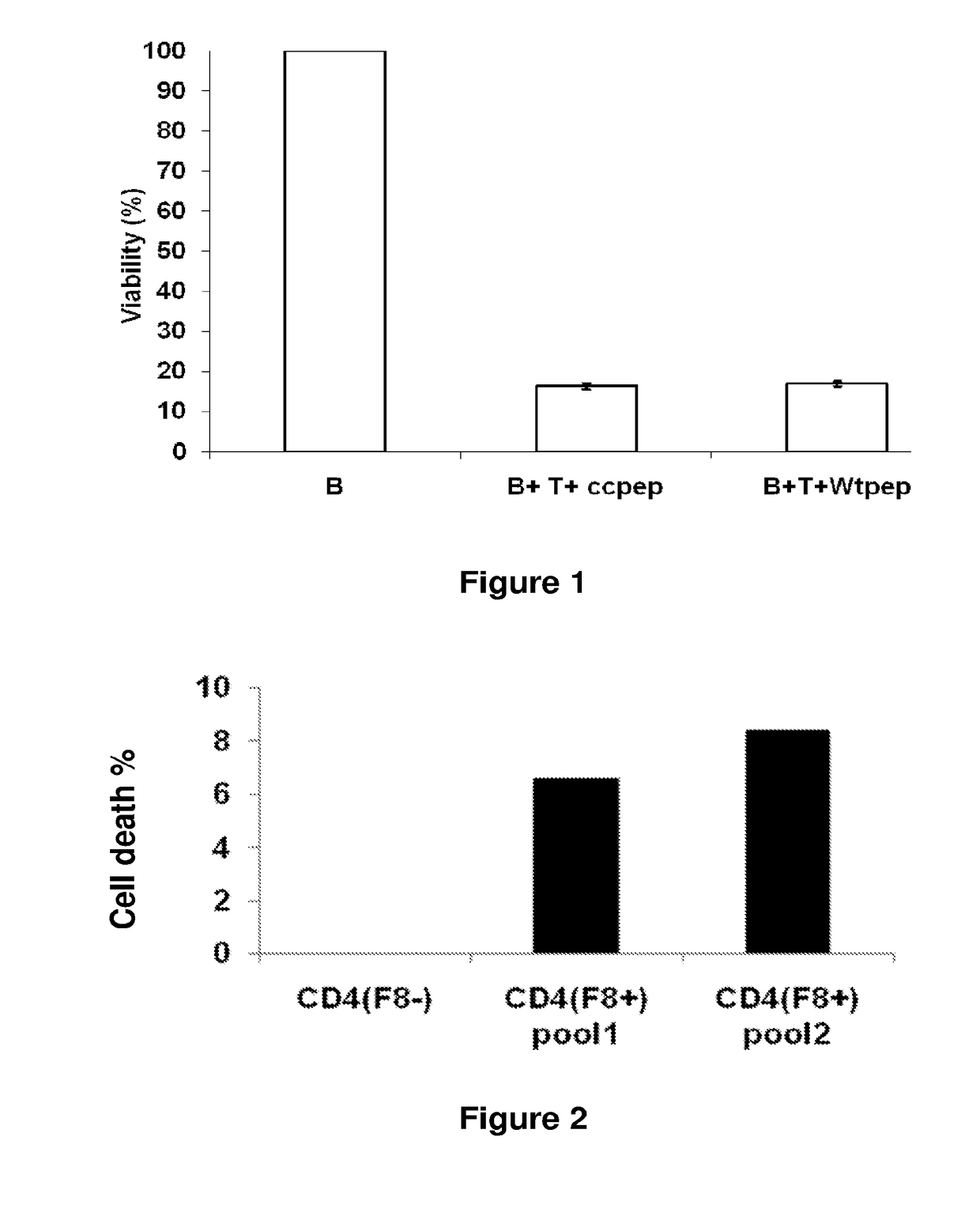Strategies to prevent and/or treat immune responses to soluble allofactors
a technology of allofactors and immune responses, applied in the field of immunogenic peptides, can solve the problems of poor antigen presentation ability of macrophages and poor ability to express antigens, and achieve the effect of suppressing immune responses
- Summary
- Abstract
- Description
- Claims
- Application Information
AI Technical Summary
Benefits of technology
Problems solved by technology
Method used
Image
Examples
example 1
into Apoptosis of Splenic B Cells of Naïve Mice Presenting a Peptide in MHC Class II Determinants
[0118]It was determined whether naïve B cells presenting a class II restricted T cell epitope derived from a BCR idiotype could be deleted by recognition and activation of T cells elicited to a specific anti-factor VIII antibody carrying the same idiotype. Thus, C57Bl / 6 mice were immunised 3 times at a fortnight interval with Fab fragments of antibody BO2C11, a human monoclonal antibody to the C2 domain of factor VIII (Jacquemin et al. (1998) Blood 92, 496-501). Ten days after the last immunisation, the mice were sacrificed and CD4+ T cells prepared from their spleen by magnetic bead sorting.
[0119]CD4+ T cells were then expanded in vitro by presentation of / contacting with a peptide identified using the above-referenced algorithms as carrying a T cell epitope. This T cell epitope is derived from the complementarity-determining region (CDR) 3 of the VH region of the BO2C11 antibody. This e...
example 2
into Apoptosis of Human B Cells Specific for Factor VIII by CD4+ T Cells Specific to a Factor VIII Epitope Presented into MHC Class II Molecules
[0125]Human lymphoblastoid B cell lines were obtained from the peripheral blood of a patient affected by a mild form of haemophilia and producing antibodies neutralising factor VIII function. A specific cell line, LE2E9 (referred to hereinafter as 2E9) produced an antibody to the carboxyterminal end of the factor VIII C1 domain (Jacquemin et al. (2000), Blood 95, 156-163). The 2E9 cell line was shown to present factor VIII derived peptides within the context of MHC class II molecule, which resulted in specific CD4+ T cell activation. Such CD4+ T cells were cloned from the peripheral blood of the same patient. The peptide recognised by such T cell clones was mapped and is of sequence: IIARY-IRLHPTHYSIRST (SEQ ID NO:3), which corresponds to amino acids 2144 to 2161 of the C1 domain and in which I in position 2149 corresponds to the first MHC a...
example 3
into Apoptosis of Human Dendritic Cells Specific for Factor VIII by CD4+ T Cells Specific to a Factor VIII Epitope
[0129]To determine whether a primary immune response to factor VIII could be prevented using modified epitopes extended with a redox motif, an experiment similar to that described in Example 2 is carried out using dendritic cells instead of a B cell line. Thus, human dendritic cells are prepared from peripheral blood monocytes by culturing these in the presence of GM-CSF and IL-4. Full maturation is then obtained by addition of TNF-alpha, according to published methods.
[0130]Dendritic cells are loaded by incubation with peptides of SEQ ID NO:3 or SEQ ID NO:4 comprising a T cell epitope of FVIII (see Example 2). After washing, dendritic cells are incubated with the factor VIII-specific T cell clone pre-activated with either peptide of SEQ ID NO:3 or SEQ ID NO:4.
[0131]These experiments demonstrate the capability of T-cell epitopes modified by the addition of a redox motif ...
PUM
| Property | Measurement | Unit |
|---|---|---|
| diameter | aaaaa | aaaaa |
| soluble | aaaaa | aaaaa |
| frequency | aaaaa | aaaaa |
Abstract
Description
Claims
Application Information
 Login to View More
Login to View More - R&D
- Intellectual Property
- Life Sciences
- Materials
- Tech Scout
- Unparalleled Data Quality
- Higher Quality Content
- 60% Fewer Hallucinations
Browse by: Latest US Patents, China's latest patents, Technical Efficacy Thesaurus, Application Domain, Technology Topic, Popular Technical Reports.
© 2025 PatSnap. All rights reserved.Legal|Privacy policy|Modern Slavery Act Transparency Statement|Sitemap|About US| Contact US: help@patsnap.com

